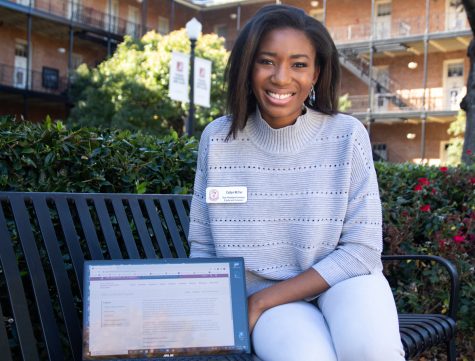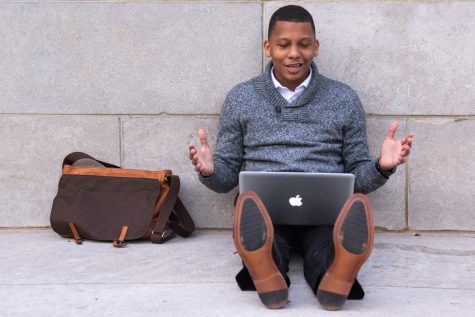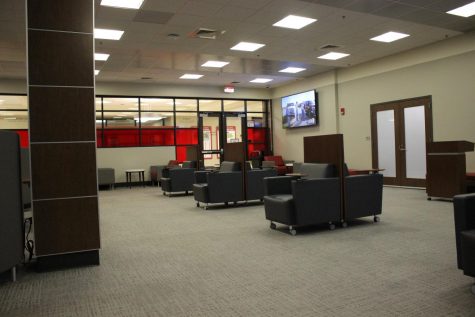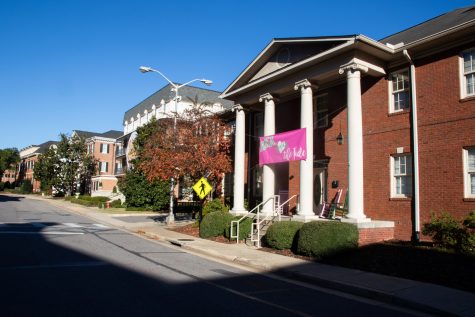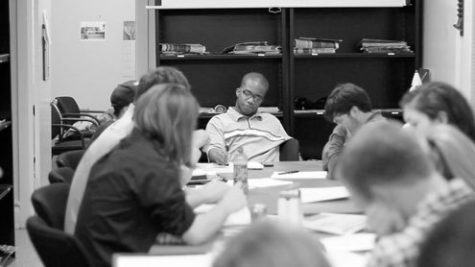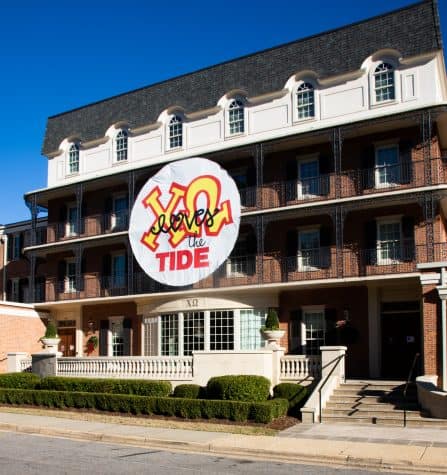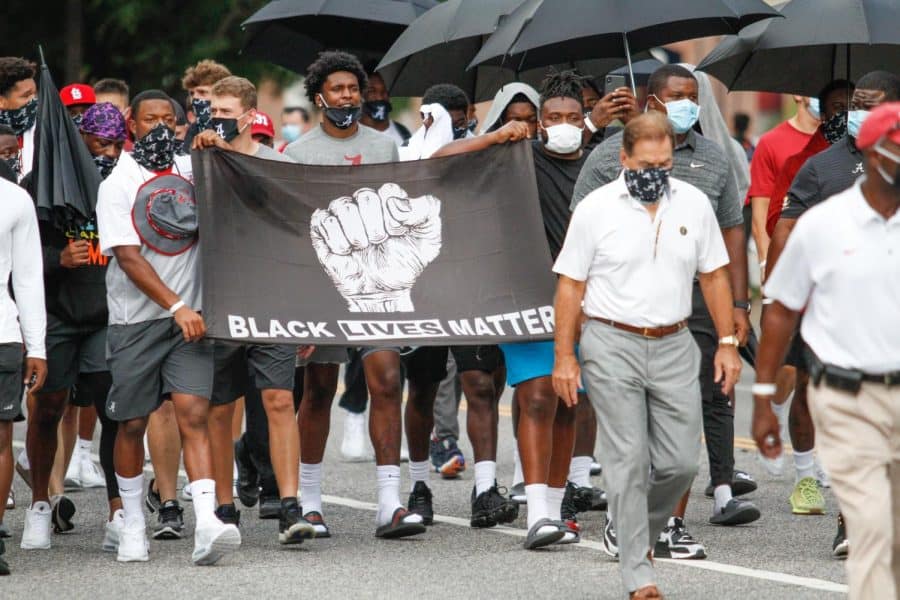Opinion | Student athletes marched, but has anything actually changed?
UA athletes captured national attention when they marched in support of Black Lives Matter in August. But maybe marching without explicit demands was a mistake.
Read more from the Dec. 3 1956 Collab Edition.
The United States was built on exploitation. The exploitation of Native American people. The exploitation of enslaved Black people. The exploitation of workers.
There has always been an oppressed population in the United States. And that oppressed population has always learned to fight back and resist, employing innovative strategies in the process.
One of those strategies has always been the exchange of ideas. Especially for Black Americans, the march to freedom was built on a network of disseminating information—sometimes furtively and sometimes loudly. Communication and collaboration was integral in bringing about every Black social movement, from slave rebellions to Black Lives Matter protests. And this communication hasn’t only been amongst contemporaries. For generations, activists have worked with the knowledge of the leaders who came before. But along with incremental progression comes so-called activists who are oblivious of the labor that has already been done. Their ideas, far-fetched and void of nuance, only force regression.
Even with the best intentions, those who don’t try to reach out to people already in the trenches of social change run the risk of doing more harm than good. The concept of doing the same activism work over again, in a needless and inefficient effort, is known as reinventing the wheel.
As much as athletes, with their national platforms and loud-mouthed naysayers on Facebook, may try to engage in social activism, they always run the risk of reinventing the wheel.
IF IT AIN’T BROKE, DON’T FIX IT
Reinventing the wheel comes up at every step of a progressive movement because it’s much easier for institutions to prioritize business as usual. While business as usual may be a perfectly reasonable system for privileged groups, it can be detrimental for those in the minority. That’s why it’s crucial that social movements keep inching forward instead of yielding to those who think treading water makes for a better photo-op.
When it comes to institutions that can keep things status quo without much pushback, universities are at the top of the list. Though students are notoriously fond of protesting, those students cycle out every four years, giving university administrators a clean slate of students who aren’t engaged with the activism of previous years. When they come face-to-face with the problems that have plagued generations past, they start over from the beginning. The only way to break that cycle in favor of something sustainable is to reach out to those off-campus, where people are rooted in the community as full-time residents with no impending expiration date.
In Tuscaloosa, those groups are everywhere—Tuscaloosa Bail Out, the UA Black Faculty and Staff Association and the UA Department of Gender and Race Studies all come to mind. These organizers are active and thriving, with no ticking clock setting a time limit on their influence.
Students are constantly working to make the UA administration see what a lopsided institution they have built. A prime example is The Black Existence Archive launching in December, whose sole purpose is to act as a contextual tool for future student activists and raise awareness around the history of Black students on campus. Another is Murder Journal, an unconventional literary journal that holds space for those challenging the relational harm and the validity of the educational institution.
These organizations were marching in June and July, lifting their voices even without students on campus. And then August came.
ALL ABOUT OPTICS?
Once students arrived on campus, student athletes were quick to organize a march in support of Black Lives Matter. Football players spearheaded the demonstration, and many of them spoke in front of Foster Auditorium alongside Nick Saban and athletics director Greg Byrne at the end of the march.
Many student athletes, like Champion Allison, a sprinter on UA’s Track and Field team, were enthused with the chance to publicly declare their stance on the matter.
“It made me feel good to see our generation stand up for something we believe in,” Allison said.
Other student athletes also supported Saban’s acts of allyship by walking alongside the athletes but still centering Black students by tapping them to deliver speeches.
“I liked that it opened a conversation on social media,” one student athlete said. “It’s actually more than just sports. You can’t just sit here and shout ‘Roll Tide’ but then go be a racist. That’s not how it works.”
It made students hopeful that maybe the conversation was shifting, but it remains unclear what the real point of the march was. Though it was explicitly stated that the march was meant to target racial injustice and call out the need for change, there were no substantive goals or demands.
Several UA athletes said that while the march seemed impactful for the optics, nothing really happened afterwards.
“On my team, there was no talk after the march, and it didn’t really change anything relating to the school,” one student athlete source said. “It didn’t really make an impact for us students.”
Another student athlete said they had to be the one to initiate conversations regarding police brutality and systemic racial issues within their team, as there was no further action from the coaching staff.
While the march may have been meant to be a call for change, it looks as though that call was ignored. What was, for a moment, a huge news story with the potential to cause major change, isn’t even a bullet point on a Wikipedia page.
There was no shift in conversation, no action toward inclusive policies and student athletes say the circumstances within their own team remain unchanged. So was the athletics department only interested in the march for the photos? Because one thing is for certain: Black people and people of color deserve more than just another symbolic parade for the cameras.
Specifically, students and student athletes need effective policy and cultural change on campus, and this is a responsibility the University and the athletics department need to be held accountable for. One student athlete said there was very little conversation at all on their team regarding racial injustice.
“I didn’t know if I wanted to be a part of the team after [the resurgence of protests in the summer],” the athlete said. “During the heat of [Black Lives Matter protests], no one talked about it, and the ambiance was, ‘This is sports, not politics.’ But this isn’t politics, these are human rights we’re talking about.”
PUT YOUR MONEY WHERE YOUR MOUTH IS
Colleges and universities in the United States generate a good bulk of revenue from student-athletes. In fact, schools in the SEC occupied five of the top 10 spots for most revenue from student athletics in 2019. The University of Alabama was ranked number seven, generating $164.1 million dollars in revenue.
Alabama football is the biggest contributor, with 59.8% of the athletics revenue coming from that sport. Men’s basketball was the next closest. The economic impact Alabama sports has on this campus is well known, but how is the University allocating that money to support the well-being of its students and the surrounding community?
Currently, 28,620 white students attend Alabama, while just over 4,000 students are Black. Black people make up 43.9% of the population in Tuscaloosa, and the poverty rate is 16.4%, above the national average of 10.5%.
The University brings in plenty of money into Tuscaloosa, but seldom uses it to promote the well-being of students. The reallocation of money to funding local organizations that support impoverished students would show that the University is in support of students facing injustice and is willing to use the money these students work hard to bring in to benefit them, not just renovate campus buildings.
Throughout this volatile year, the University administration has done a commendable job of saving face in response to student-initiated petitions that demanded the renaming of buildings on campus who honored the legacies of men tied to Confederate leadership, slavery and eugenics. Students pushed for renaming with the intent to highlight the diversity of the history of Black people and people of color on campus. Instead of hearing those ideas out, the UA Board of Trustees gave the buildings generic names that only frustrated students more.
HOW CAN CAMPUS CULTURE SHIFT TOWARD INCLUSIVITY?
Randall Ceneus, an Auburn alumnus and previous track and field captain, was complimentary of Auburn’s approach to conversations centering race, as the coaching staff initiated frequent panels and conversations amongst student athletes.
“If student athletes became more knowledgeable about challenging infrastructure of institutions that disadvantage Black people, then they could use the attention they get in order to shift the conversation,” Ceneus said. “Student athletes carry a lot of influence on campus. If they are very intelligent towards these social issues, they could convey this more in campus culture.”
It’s clear now that there is much to be done regarding the University’s behavior toward Black people and people of color on campus.
All of the student athlete sources interviewed for this column agreed with that sentiment and offered their perspectives on what could be done. Two sources agreed that a start to real change could begin with Black Greek life. Currently, only one Black sorority and one Black fraternity have on-campus housing. Those two student athletes agreed that Black Greek life deserves more and better housing. More substantial change could be made at the administrative level, as well as recruiting more diverse candidates for professorship and retaining those candidates for tenure.
Any way you consider it, it’s clear that the University needs to do more than get football players permits to march up the street. It’s time to go beyond listening and act.




